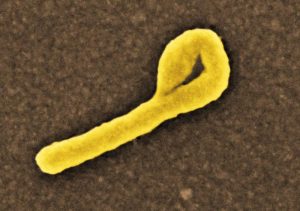The fight to contain the 2013-16 Ebola outbreak in West Africa was hampered by the lack of an effective treatment or vaccine.

Researchers funded in part by the National Institute of Allergy and Infectious Diseases (NIAID), part of the National Institutes of Health (NIH), have studied the blood of an Ebola survivor, searching for human antibodies that might effectively treat not only people infected with Ebola virus, but those infected with related viruses as well. Now the researchers have identified two such antibodies that hold promise as Ebola treatments.
Previously, researchers had discovered only one antibody—from a mouse—capable of protecting mice against multiple different species in the ebolavirus lineage. To find similar broadly protective human antibodies, researchers surveyed 349 human monoclonal antibodies derived from the blood of one survivor of the recent West African Ebola outbreak, which was caused by Zaire ebolavirus. They searched specifically for antibodies that might neutralize all five common ebolavirus species.
The researchers mined the human immune response to natural infection by the Ebola virus and found two antibodies, ADI-15878 and ADI-15742, which recognized the GP fusion loop — a section of a protein found on the surface of the Ebola virus. By analyzing the structure of these antibodies and testing their action on the viruses, the researchers determined that when given access to the GP fusion loop, the antibodies could likely block the five related ebolaviruses from entering a host cell. Moreover, when tested with human cells in a laboratory setting, the antibodies protected the cells from becoming infected with several different virulent ebolaviruses.
Read more at NIH
AC Wec, et al. Antibodies from a human survivor define sites of vulnerability for broad protection against ebolaviruses(link is external). Cell DOI: 10.1016/j.cell.2017.04.037 (2017).

